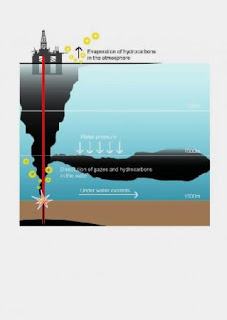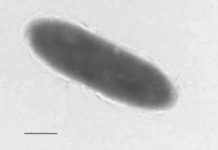
For the first time, scientists gathered oil and gas directly as it escaped from a deep ocean wellhead – that of the damaged Deepwater Horizon oil rig. What they found allows a better understanding of how pollution is partitioned and transported in the depths of the Gulf of Mexico and permits superior estimation of the environmental impact of escaping oil, allowing for a more precise evaluation of previously estimated repercussions on seafloor life in the future.
The explosion of the Deepwater Horizon rig in April 2010 was both a human and an environmental catastrophe. Getting the spill under control was an enormous challenge. The main problem was the depth of the well, nearly 1,500 meters below the sea surface. It was a configuration that had never been tried before, and the pollution it unleashed after methane gas shot to the surface and ignited in a fiery explosion is also unequalled. Much research has been done since the spill on the effects on marine life at the ocean’s surface and in coastal regions. Now, École Polytechnique Fédérale de Lausanne (EPFL) professor Samuel Arey and the Woods Hole Oceanographic Institute reveal in the advance online edition of Proceedings of the National Academy of Sciences how escaped crude oil and gas behave in the deep water environment.
Into the deep
In June 2010, with the help of a remotely operated vehicle (ROV), Woods Hole scientists reached the base of the rig and gathered samples directly from the wellhead using a robotic arm. The oceanographers also made more than 200 other measurements at various water depths over a 30-kilometer area. These samples were then analyzed with the help of the US National Oceanic and Atmospheric Administration and the dissolution of hydrocarbons was modeled at EPFL. This model showed how the properties of hydrocarbons are important in understanding the wellhead structure and pollution diffusion-how pollution spreads out-in the depths.
From the ROV to the lab
Lab analysis led the scientists to describe for the first time the physical basis for the deep sea trajectories of light-weight, water-soluble hydrocarbons such as methane, benzene, and naphthalene released from the base of the rig. The researchers observed, for example, that at a little more than 1,000 meters below the surface, a large plume spread out from the original gusher, moving horizontally in a southwest direction with prevailing currents. Unlike a surface spill, from which these volatile compounds evaporate into the atmosphere, in the deep water under pressure, light hydrocarbon components predominantly dissolve or form hydrates, compounds containing water molecules. And depending on its properties, the resulting complex mixture can rise, sink, or even remain suspended in the water, and possibly go on to cause damage to seafloor life far from the original spill.
By comparing the oil and gas escaping from the well with the mixture at the surface, EPFL’s Samuel Arey, head of Environmental Chemistry Modeling Laboratory, and colleagues were able to show that the composition of the deep sea plumes could be explained by significant dissolution of light hydrocarbons at 1 kilometer depth. In other words, an important part of the oil spreads out in underwater plumes, so we need a more precise evaluation of previously estimated repercussions on seafloor life in the future. Arey’s methodology offers a better estimation of how pollution travels and the potential deep sea consequences of spills.
“Modeling the environmental fate of hydrocarbons in deep water ecosystems required a new approach, with a global view, in order to correctly understand the impact of the pollution,” explains Arey. This research will have a significant impact on assessments of the environmental impact of deep water oil spills.
Note: This story has been adapted from a news release issued by the Ecole Polytechnique Fédérale de Lausanne










